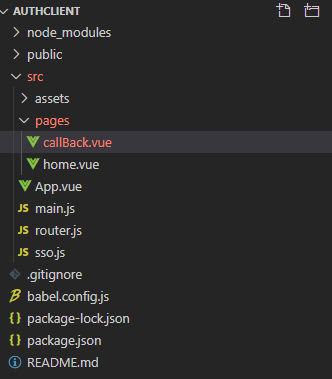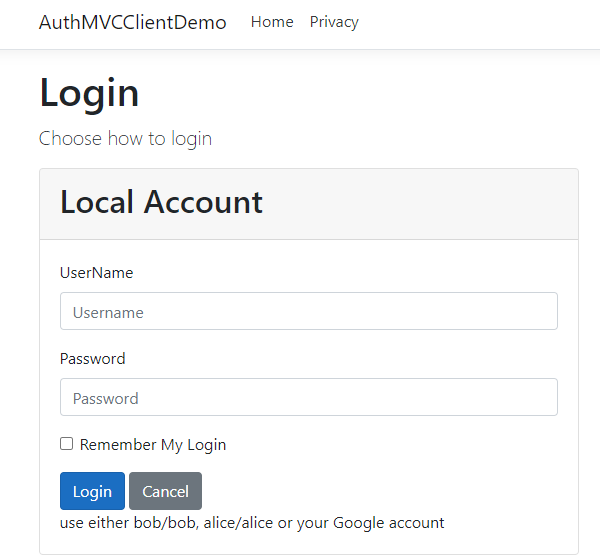6. JS客户端基于隐式授权码模式实现单点登录 (VUE SPA 使用 oidc-client.js)
1. 概述
-
本例将在上一个实例基础上实现纯js客户端认证,使用vue-cli 脚手架创建客户端app.
-
使用oidc-client.js 组件,默认使用cookie 保存客户端凭据。
2. 服务端添加Client
纯js客户端需要新增一个client,并需要显式声明允许浏览器url 传递accesstoken,Conig 类新增代码如下:
new Client
{
ClientId="js",
ClientName="vue Client",
RequireConsent=false,
AllowAccessTokensViaBrowser=true,
AllowedGrantTypes= GrantTypes.Implicit, // 隐式授权码
RedirectUris={"http://localhost:8080/callback"},
PostLogoutRedirectUris={"http://localhost:8080/logout"},
AllowedScopes= new List<string>
{
IdentityServerConstants.StandardScopes.OpenId,
IdentityServerConstants.StandardScopes.Profile
}
}
3. Vue客户端
3.1 准备vue client 工程项目
// 使用vue-cli 脚手架创建工程
vue create authclient
// 引用router 组件
npm isntall vue-router --s
// 引用oidc-client 组件
npm install oidc-client --s
3.2 创建两个页面组件(home & callback)
import Vue from 'vue'
import Router from 'vue-router'
import callback from '@/pages/callBack.vue'
import home from '@/pages/home.vue'
Vue.use(Router)
export default new Router({
mode: 'history',
routes: [{
path: '/',
component: home,
},
{
path:'/callback',
name:'callback',
component:callback
}
]
})
3.3 创建路由页面组件
// home
<template>
<div class="hello">
<h1>home page</h1>
</div>
</template>
<script>
export default {
name: 'HelloWorld',
props: {
msg: String
}
}
</script>
<!-- Add "scoped" attribute to limit CSS to this component only -->
<style scoped>
h3 {
margin: 40px 0 0;
}
ul {
list-style-type: none;
padding: 0;
}
li {
display: inline-block;
margin: 0 10px;
}
a {
color: #42b983;
}
</style>
// callback
<template>
<div>callback</div>
</template>
<script>
export default {
name: 'callback',
mounted() {
this.$userManager.signinRedirectCallback().then(
(u) => {
console.log(u);
window.history.replaceState(
{},
window.document.title,
window.location.origin + window.location.pathname
);
window.location = '/';
},
(error) => {
console.log(error);
}
);
},
};
</script>
3.4 添加sso 组件,用于配置oidc客户端
import Oidc from 'oidc-client'
const host = location.origin
const authsServer = 'http://localhost:5010'
const userManager = new Oidc.UserManager({
authority: authsServer, // server 地址
client_id: 'js', // client id
post_logout_redirect_uri: `${host}/logout`, // 退出登录
redirect_uri: `${host}/callback`,
silent_redirect_uri: `${host}/callback`,
accessTokenExpiringNotificationTime: 4, // 超时
silentRequestTimeout: 2000, //
response_type: 'token id_token',
scope: 'openid profile',
filterProtocolClaims: true
})
userManager.events.addUserSignedOut(() => {
userManager.removeUser().then(() => {
userManager.signinRedirect().catch(()=>{
console.error('error wihile logout')
})
})
})
export default userManager;
3.5 main.js 注册oidc 和路由
import Vue from 'vue'
import App from './App.vue'
import userManager from './sso.js'
import router from './router.js'
Vue.config.productionTip = false
Vue.prototype.$userManager = userManager
router.beforeEach(async (to, from, next) => {
if (to.name === 'callback') {
next()
} else if (to.name === 'logout') {
console.log('log out....')
} else {
const user = await userManager.getUser();
if (user) {
next()
}
else {
userManager.signinRedirect().catch(error => {
console.error(error)
})
}
}
})
new Vue({
router,
render: h => h(App),
}).$mount('#app')
最终项目目录如下:

4. 启动调试
- 先启服务器,再启客户端,此时客户端路由拦截器会重定向到localhost:5010 登录页
![]()
- 输入之前配置的用户名密码,认证成功后会经过callback页面,跳转到客户端首页,并写入cookie,sessionstorage
![]()







 浙公网安备 33010602011771号
浙公网安备 33010602011771号